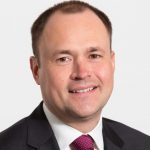
The government has finally published its long-awaited report from the Elective Recovery Taskforce, setting out plans to use the independent sector more widely and more effectively to help tackle the backlog. IHPN CEO David Hare looks at what the measures might mean for providers
This month’s column is one that I have long been waiting to write. After some months, we have finally seen the publication of the long-awaited government report accompanying the Elective Recovery Taskforce.
So now it’s out, how did we get here, what’s the substance and what does it all mean?
The report itself (and hopefully I can say this as I did co-write the foreword!) is not a ‘big reveal’ of new ideas; much of it will be familiar to readers through the Blair reforms of the 2000’s and some of the announcements and commitments were made earlier this year.
One of the interesting points about how this work has unfolded over the past few months has been that rather than save all the big announcements to the end, the process has been more iterative – for example the Prime Minister’s announcement on patient choice at the end of May.
To be honest, I’m okay with that. What interests me more is the overall implications, the wider context, and where we go next.
As a quick recap, the Taskforce itself first convened at the end of last year, and I, along with colleagues from the independent sector, the NHS, government, and a large range of other stakeholders, including patient groups, were all involved.
The objective was to try and establish a programme of shared ambitions, and alight on ways that we could do more to harness the capital, capacity and capability of the independent sector to tackle the growing NHS waiting lists.
As we embarked on that process, there were four strategic issues that we saw as key priorities which either needed to be further embedded, firmed up, or highlighted for attention, both inside and outside the taskforce process:
- Payment by results – we felt that there needed to be a return to a method of payment by elective activity (both for NHS and independent providers) to ensure that everyone – NHS and independent sector – was being incentivised appropriately to treat as many patients as possible, as quickly as possible.
- Patient choice – we (and patient groups) were acutely aware that patients simply did not know about their rights to choose how and where they could receive their NHS care, and there were concerns that signposting to the independent sector was not effective or not happening at all.
- Procurement/the marketplace – how can the procurement landscape be improved to ensure that the playing field is level, that independent providers can access the market, and that decision making is transparent and fair?
- Diagnostic capability and capacity – how can we boost utilisation of the significant opportunities presented by the private sector to deliver additional diagnostic capacity?
The taskforce had its last formal meeting in March, and at that point, with a draft report and recommendations in place, it was clear on a number of key areas, so in the intervening months, we have seen, and members are reporting, some progress, which is encouraging.
So how are we progressing in those key areas?
- Payment by results
Following conversations with NHS England (NHSE) and the Department of Health and Social Care (DHSC), the NHS Payment Scheme for 2023/24 saw the reintroduction of payment by results for elective activity for both the independent sector and NHS providers. This, we feel, is definite progress in terms of reducing financial blockers to the movement of elective activity between providers – including IS providers – so that’s in a decent place.
- Patient choice
At the end of May, Prime Minister Rishi Sunak personally fronted a significant announcement saying he wanted to make it much easier for patients to choose where they receive their NHS care, and that improvements to the NHS app would be made, along with a public awareness campaign.
This in itself is significant – to have the personal commitment of the Prime Minister in such a clear and explicit way was, I think, both welcome and unusual. The Prime Minister was clear in his support, saying: ‘Currently, just one in ten patients make a choice about where they receive care. We want to change that by helping the NHS to offer patients a real choice while also giving patients the information they need to decide’.
The PM added: ‘Our aim is to create an NHS built around patients, where everyone has more control over the care they receive, wherever they live or whatever their health needs are.’
As I said at the time, both the awareness campaign and using the NHS app are welcome steps. We know there have been developments in the background in terms of the app, and that progress is being made to try and improve the accuracy of information and the functionality, although this remains a work in progress.
On the public information campaign, our understanding is that this will begin in earnest in the autumn, so we are engaging with partners including DHSC and NHSE to shape that.
- Procurement/Provider Selection Regime
Just a few weeks ago, the government announced (following a consultation to which we responded) the Provider Selection Regime (PSR). The PSR is an important set of rules to support fair play and the final PSR sets out an approach which we think is positive for all concerned and certainly much better than the proposals initially consulted upon some time ago.
One of the most significant changes we believe is the move to establish independent oversight to resolve complaints which will help bring transparency and consistency to decision making.
There will be two independent panels – one relating to choice issues, and one for procurement issues – but operating as one. This is a positive step because by ensuring transparency and consistency in decision making, it will help to give patients and taxpayers maximum confidence about the decisions made on their behalf.
There’s more for us to do to ensure that guidance is issued and that providers are well equipped to work constructively with the NHS under the new rules, and that there’s a good wider understanding of how this will all work in practice, but again we see this as a very positive step.
- Diagnostic capability and capacity
We were pleased to see the commitment to opening further independent sector-led Community Diagnostic Centres (CDCs). However, we believe this really can and should be dialled up significantly.
CDCs are undoubtedly a key piece of the jigsaw. We know that millions of people are waiting for diagnostic appointments, tests, and scans. The principle of providing easily accessible capacity, in convenient locations (crucially, away from hospital sites to shield this activity from the urgent and emergency pathway) seems spot on, but we have to adhere to the principle!
We feel this is still an area of huge untapped potential that makes massive sense from a financial perspective – why would we not want to lever private sector capital to build the facilities, rather than fund them from NHS budgets?
It’s also really important that we are seeing CDCs as the route to additional capacity, not just moving around activity which would already have been undertaken.
So, overall, where are we? As I have said before, but I think it bears repeating, we have made some great progress.
The idea of a taskforce, set up directly by the Prime Minister, with the explicit purpose of finding ways to maximise the contribution of the independent sector in tackling NHS backlogs, would have seemed out of the question not too long ago.
Lots of the work done in the past few months has been moving in the right direction. It’s always easy to say we could do more, go further, move faster.
But, in the wider context, particularly in political terms, reflecting on the historically polarised and often hysterical debate which usually surrounds private healthcare’s role in the NHS,
“to be in a place where both Conservatives and Labour leaderships can see the value of the independent sector, is no mean feat.”
The key now will be how we operationalise things and make real progress. It won’t be straightforward.
One of the key features of the taskforce over the past four months has been the spirit of collaboration and shared endeavour.
The ambition now must be delivering the translation of the shared priorities from this report out into the real world. It’s going to take effort and commitment, particularly from GPs and partners in the NHS, and patients will undoubtedly need more support and education, but the potential benefits for patients are huge, and the independent sector stands ready to support.








 ©2024 All rights reserved LaingBuisson
©2024 All rights reserved LaingBuisson 


